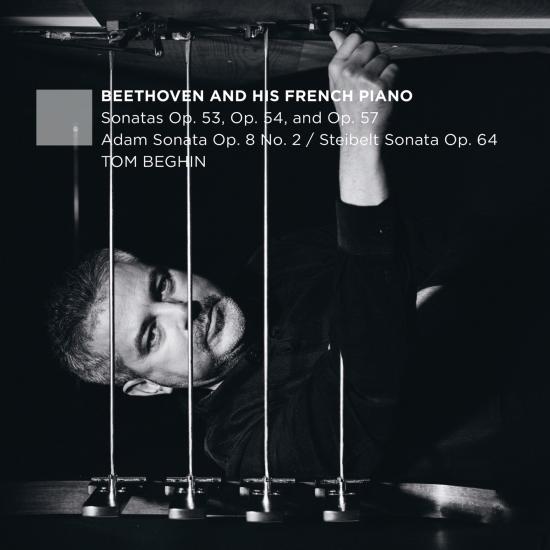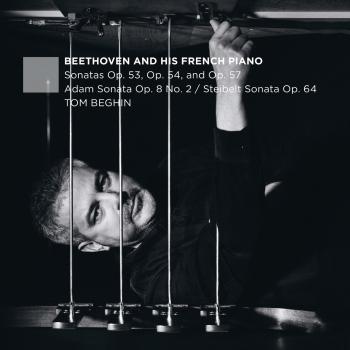
Beethoven and His French Piano Tom Beghin
Album info
Album-Release:
2020
HRA-Release:
06.11.2020
Label: Evil Penguin Classic
Genre: Classical
Subgenre: Instrumental
Artist: Tom Beghin
Composer: Ludwig van Beethoven (1770–1827)
Album including Album cover
- Ludwig van Beethoven (1770 - 1827): Concerto in G Major, Op. 58:
- 1Concerto in G Major, Op. 58: II. Andante con moto, "2da parte"01:46
- Louis Adam (1758 - 1848): Méthode de Piano du Conservatoire:
- 2Méthode de Piano du Conservatoire: Exercise No. 4800:33
- Louis Adam: Sonata in C Major, Op. 8 No. 2:
- 3Sonata in C Major, Op. 8 No. 2: I. Allegro di molto15:12
- 4Sonata in C Major, Op. 8 No. 2: II. Romance Andante grazioso un peu animé / Adagio non troppo10:46
- 5Sonata in C Major, Op. 8 No. 2: III. Finale: Scherzando: Allegro vivace05:54
- Ludwig van Beethoven: Eroica Sketchbook:
- 6Eroica Sketchbook: Excercise00:37
- Ludwig van Beethoven: Piano Sonata in C Major, No. 21, Op. 53:
- 7Piano Sonata in C Major, No. 21, Op. 53: I. Allegro con brio (Reconstituted Four-Movement Version)16:47
- 8Piano Sonata in C Major, No. 21, Op. 53: II. Allegretto (WoO 56) (Reconstituted Four-Movement Version)01:55
- 9Piano Sonata in C Major, No. 21, Op. 53 : III. Andante grazioso con moto (WoO 57) (Reconstituted Four-Movement Version)08:39
- 10Piano Sonata in C Major, No. 21, Op. 53: IV. Introduzione Adagio molto – Rondo Allegretto moderato (Reconstituted Four-Movement Version)12:33
- 11Piano Sonata in C Major, No. 21, Op. 53: Appendix: Introduzione: Adagio molto (As Published)03:09
- Ludwig van Beethoven: Piano Sonata in F Major, No. 22, Op. 54:
- 12Piano Sonata in F Major, No. 22, Op. 54: I. In Tempo d'un Menuetto05:59
- 13Piano Sonata in F Major, No. 22, Op. 54: II. Allegretto / Più allegro06:54
- 14Piano Sonata in F Minor, No. 23, Op. 57: I. Allegro assai10:41
- 15Piano Sonata in F Minor, No. 23, Op. 57: II. Andante con moto05:38
- 16Piano Sonata in F Minor, No. 23, Op. 57: III. Allegro ma non troppo / Presto08:42
- Daniel Steibelt (1765 - 1823): Sonata in G Major, Op. 64:
- 17Sonata in G Major, Op. 64: I. Cantabile con espressione22:19
- 18Sonata in G Major, Op. 64: II. Tempo di Minuetto: Scherzando02:55
- 19Sonata in G Major, Op. 64: III. Adagio: Fantaisie11:45
- 20Sonata in G Major, Op. 64: IV. Pastorale: Allegretto07:39
Info for Beethoven and His French Piano
In October 1803, a new piano came into Beethoven’s life. Made by the Erard brothers in Paris it bore the serial number 133, showing it was the 133rd such grand piano Erard Frères had built since 1797. The composer was “so enchanted with it,” a visitor reported, “that he regards all the pianos made here as rubbish by comparison.” But while the sound of the French piano may have been superb, its touch was significantly heavier than any of the Viennese pianos Beethoven was used to, so he put his trust in the skills of a local piano technician, who made a series of technical adjustments. In the process, however, the unique properties of the instrument were severely compromised, and in 1809 Beethoven had no choice but to declare his French piano “now utterly useless.” Initially holding on to it as a “souvenir,” he eventually bequeathed the scarred piano to his brother Johann, who donated it to the Oberösterreichisches Landesmuseum in Linz, Austria.
As part of a project to better understand the importance of the Erard piano to Beethoven, an exact replica of the instrument was built at the Orpheus Institute, restoring it to its pre-adjusted state. It can be heard on this recording for the first time.
Tom Beghin presents new readings of a trilogy of sonatas that Beethoven started writing shortly after receiving the new instrument: Op. 53 (“Waldstein,” performed here in its original four-movement version), Op. 54, and Op. 57 (“Appassionata”), spanning the years 1803 to 1807. Two additional sonatas by contemporaries Daniel Steibelt (Op. 64, from 1805) and Louis Adam (Op. 8 No. 2, from 1801) provide an appropriately French musical context, while also representing excellence in their own right.
At the time Beethoven acquired his Erard piano, he was dreaming of relocating to Paris. He never did— but listening to this new recording we can hear how Paris came to him. Inspired by his French piano, Beethoven mastered the technique of son continu (“continuous sound”) and experimented with the sonic effects afforded by the instrument’s four pedals, following the examples of his one-time rival, Daniel Steibelt, famed for his showy virtuosity, and Louis Adam, the foremost piano professor at the recently founded Paris Conservatoire.
These recorded performances invite listeners into a revolutionary world of pianistic sonority and effect, in which feet on pedals matter as much as fingers on the keyboard—a space where Beethoven, if only for a while, managed to create a French version of himself.
Tom Beghin, piano
Recorded on the replica of Beethoven’s Erard Frères piano (Paris, 1803) by Chris Maene (Ruiselede, 2016)
Tom Beghin
has been at the forefront of a new generation of interpreters of 18th- and early 19th-century music.
His discography features Beethoven, Mozart, Haydn, Moscheles, C.P.E. Bach, Mendelssohn, Zelter, Schubert, and Clementi. He has published in journals such as Keyboard Perspectives, 19th Century Music and Haydn Studien, and in collections such as Haydn and His World, The Cambridge Companion to Haydn, or The Oxford Handbook of Topic Theory. With classicist Sander Goldberg he edited Haydn and the Performance of Rhetoric, winner of the 2009 Ruth Solie Award from the American Musicological Society. In 2015 The University of Chicago Press published his monograph The Virtual Haydn: Paradox of a Twenty-First Century Keyboardist.
Recognized for his expertise in eighteenth-century music, he is frequently invited to give concerts, workshops and lectures throughout North America and Europe. In 2013 he inaugurated the first replica of Beethoven’s 1817 Broadwood piano at the Concertgebouw in Bruges and the Beethoven-Haus in Bonn, playing among others Beethoven’s “Hammerklavier” Sonata, Opus 106. In 2004 the Haydn-Institut inducted him as a member. Released by Naxos on Blu-ray (2009) and CD/DVD (2011) is a complete recording of Haydn’s solo keyboard works, performed on seven different types of instruments in nine “virtual rooms.” Hailed as “one of the most audacious recording enterprises in recent memory” (blu-ray.com), The Virtual Haydn was nominated for a 2011 Juno for “Music DVD of the Year.”
He is presently focusing his artistic research on the piano works of Ludwig van Beethoven and the intersection of technology and rhetoric. Tom Beghin studied at the Lemmens Institute in Louvain, Belgium (with Alan Weiss), at the Musik-Akademie in Basel, Switzerland (with Jean Goverts and Rudolf Buchbinder), and received his doctoral degree with fortepianist Malcolm Bilson and musicologist James Webster from Cornell University (Ithaca, New York). He served on the faculty at the University of California, Los Angeles, was a fellow at the National Humanities Center (North Carolina), and was Associate Professor at the Schulich School of Music of McGill University (Montreal, Canada). Prof. Beghin has served on the board of directors of the Westfield Center for Historical Keyboard Instruments and of CIRMMT (Centre for Interdisciplinary Research in Music Media and Technology).
This album contains no booklet.











